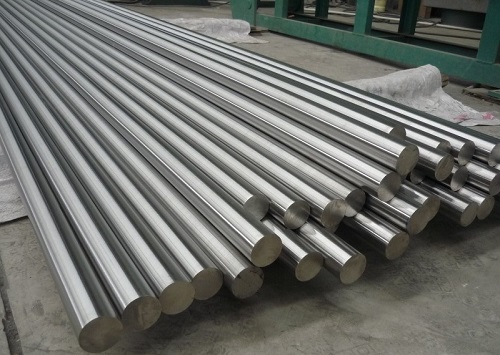Categories
- Pipe & Tube (18)
- Flange & Fitting (97)
- Fastener & Gasket (12)
- Valve & Pump (18)
- Base Material (11)
- Equipment (8)
- Application (30)
- Technical (110)
Due to the high specific strength and excellent corrosion resistance, commercially pure titanium Grade 2 is considered for a wide range of industrial applications. Grade 2 titanium exhibits strong springback in cold forming process resulting from its much lower modulus of elasticity compared to steels. This particular elastic behavior shall be taken into account carefully.

ASTM B348 titanium Grade 2 (UNS R50400) round bars, 50 mm (diameter) x 3000 mm (length), supplied to Osaka, Japan.
The modulus of elasticity (E), or Young’s modulus, is the slope of the stress-strain curve in the elastic region of the metal. The relationship between stress (σ) and strain (ε) in the elastic region is known as Hooke’s Law: E = σ / ε. The modulus of elasticity is closely related to the binding energies of the atoms. It is considered a microstructure insensitive property since the value is dominated by the stiffness of atomic bonds. A steep slope indicates that high forces are required to separate the atoms and cause the metal to stretch elastically. Thus, the metal has a high modulus of elasticity. Binding forces, and thus the modulus of elasticity, are typically higher for high melting point materials.
| Temperature | Elastic Modulus |
|---|---|
| 70 | 15.5 |
| 200 | 15.0 |
| 300 | 14.6 |
| 400 | 14.0 |
| 500 | 13.3 |
| 600 | 12.6 |
| 700 | 11.9 |
| 800 | 11.2 |
| Temperature °F | Ecs x106psi | Eau.ss x106psi |
|---|---|---|
| -325 | 31.4 | 30.3 |
| -200 | 30.8 | 29.7 |
| -100 | 30.3 | 29.2 |
| 70 | 29.4 | 28.3 |
| 200 | 28.8 | 27.5 |
| 300 | 28.3 | 27.0 |
| 400 | 27.9 | 26.4 |
| 500 | 27.3 | 25.9 |
| 600 | 26.5 | 25.3 |
| 700 | 25.5 | 24.8 |
| 800 | 24.2 | 24.1 |
| 900 | 22.5 | 23.5 |
| 1000 | 20.4 | 22.8 |
| 1100 | 18.0 | 22.0 |
| 1200 | - | 21.2 |
| 1300 | - | 20.3 |
| 1400 | - | 19.2 |
| 1500 | - | 18.1 |
The Modulus of elasticity of Grade 2 titanium at room temperature (70°F) is only approximate half of that of the low carbon steels and conventional austenitic stainless steels. It indicates much higher elastic deformation during the cold forming process. The elastic deformation will be spontaneously restored after cold forming, which is known as springback. The strong springback makes the cold forming of Grade 2 titanium technically difficult and cost intensive. Sometimes it may even develop after long storage times. Hot working at temperatures of about 480 to 650 °C, or cold forming with a subsequent hot calibration, may completely solve this notorious problem.
